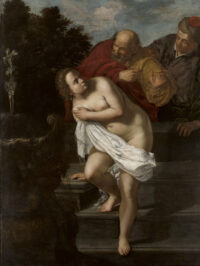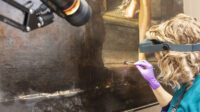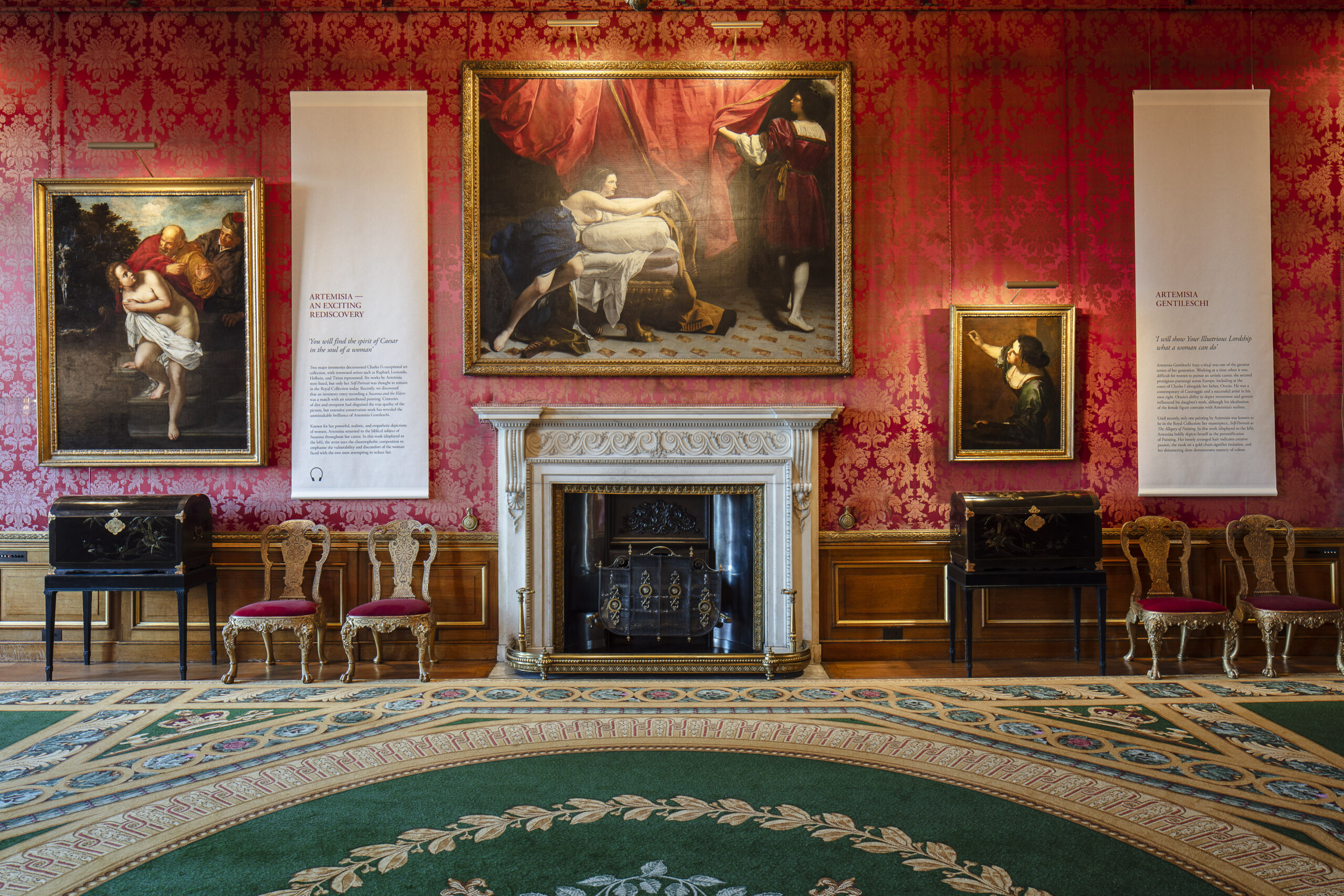 A painting of Susanna and the Elders by Artemisia Gentileschi has been rediscovered in an attic at Hampton Court Palace after centuries of neglect and misattribution. The oil on canvas work dates to around 1638 or 1639 when Artemisia was living in London and working with her father Orazio at the court of King Charles I. The monarch and his consort were avid supporters of Baroque trailblazer Artemisia Gentileschi’s work. There were seven of her paintings in the collection of Charles I, almost all of them lost in the turmoil of civil war, regicide and Protectorate. Before this rediscovery of Susanna, the only Artemisia Gentileschi still known to be in the Royal Collection was Self-Portrait as the Allegory of Painting (‘La Pittura’), an iconic work that is considered one of her greatest masterpieces.
A painting of Susanna and the Elders by Artemisia Gentileschi has been rediscovered in an attic at Hampton Court Palace after centuries of neglect and misattribution. The oil on canvas work dates to around 1638 or 1639 when Artemisia was living in London and working with her father Orazio at the court of King Charles I. The monarch and his consort were avid supporters of Baroque trailblazer Artemisia Gentileschi’s work. There were seven of her paintings in the collection of Charles I, almost all of them lost in the turmoil of civil war, regicide and Protectorate. Before this rediscovery of Susanna, the only Artemisia Gentileschi still known to be in the Royal Collection was Self-Portrait as the Allegory of Painting (‘La Pittura’), an iconic work that is considered one of her greatest masterpieces.
Susanna and the Elders was commissioned by Charles’ wife Queen Henrietta Maria when she redecorated her apartments in preparation for the imminent arrival of a new baby. A 1639 inventory records that the painting occupied a primo spot above the fireplace in the Queen’s Withdrawing Chamber, a small, private receiving room in Henrietta Maria’s apartments at Whitehall Palace.
The painting was returned to Charles II shortly after the Restoration in 1660 and is thought to have hung above a fireplace at Somerset House, home to queens and consorts including Catherine of Braganza and Queen Anne. In the 18th century, as Artemisia’s reputation waned, the painting appears to have lost its attribution. It was moved to Kensington Palace, where it is depicted in a watercolour of the Queen’s Bedchamber in 1819 leaning against a wall, suggesting it was considered the work of a minor or unkown artist and not worthy of hanging. It was later transferred to Hampton Court Palace, where at some point it lost its frame, and in 1862 it was described as ‘in a bad state’ and sent for restoration, at which point additional layers of varnish and overpaint were likely applied.
 Royal Collection Trust curators rediscovered it as part of a research project tracing the paintings that were sold off after the beheading of Charles I. It was darkened from a thick layer of discolored varnish and had been heavily overpainted, but it matched the description of Susanna and the Elders by Artemisia Gentileschi’s recorded in the inventories of Charles I. Conservators found the mark “CR” (“Carolus Rex) on the back of the canvas, confirming that it was part of the collection of Charles I.
Royal Collection Trust curators rediscovered it as part of a research project tracing the paintings that were sold off after the beheading of Charles I. It was darkened from a thick layer of discolored varnish and had been heavily overpainted, but it matched the description of Susanna and the Elders by Artemisia Gentileschi’s recorded in the inventories of Charles I. Conservators found the mark “CR” (“Carolus Rex) on the back of the canvas, confirming that it was part of the collection of Charles I.
Since its rediscovery, the painting has undergone significant treatment by Royal Collection Trust conservators. Work included the painstaking removal of centuries of surface dirt, discoloured varnish and non-original paint layers to reveal the original composition; removing canvas strips that were added to enlarge the painting sometime after its creation; relining the canvas; retouching old damages; and commissioning a new frame.
Analysis of the painting during conservation has confirmed the reattribution and given an insight into Artemisia’s working practices. She is thought to have travelled with a stock of tracings or drawings that she used to create new compositions, and conservators found that at least four parts of the painting were also used in previous works, including the Elders’ heads and Susanna’s face. Artemisia must have considered this Susanna particularly accomplished, as she reused elements of the figure in at least three versions of her later painting Bathsheba. X-radiography (used to analyse aspects of a work not visible to the naked eye) and infrared reflectography (used to make underdrawing visible) have also revealed changes that Artemisia made to the composition, uncovering a large fountain that she subsequently painted out with trees.
The restored Susanna and the Elders has gone on display in the Queen’s Drawing Room at Windsor Castle next to Orazio Gentileschi’s Joseph and Potiphar’s Wife, Artemisia’s allegorical self-portrait and other works from the Stuart collection.

Unfortunately, I am not convinced. The artwork here appears almost like a ‘trading peace’ that Orazio might have blotted together while on the road.
Near Bamberg, Schloss Weißenstein in Pommersfelden, a masterwork of Baroque architecture, was built as a modest private summer residence for Lothar Franz von Schönborn, Prince-Bishop of Bamberg and Archbishop of Mainz, to designs by Johann Dientzenhofer and Johann Lukas von Hildebrandt.
Myself, I have been there in June: The Schönborn’s 1610 version of Artemisia’s “Susanna and the Elders” differs in style and composition and is obviously more advanced: In Pommersfelden, Susanna appears to be more harassed, and the Elders much more lecherous and voyeuristic.
when was it rediscovered?
Pretty! This has been a really wonderful post. Many thanks for providing these details.
Please tell me how can an attic at Hampton palace be overlooked? Nobody was bothered to explore? Really the lack of enthusiasm is just shocking.
Fascinating post, thank you! I wrote a book, published in 2021 in the UK and 2022 in the US, depicting the discovery of a series of Artemisia Gentileschi paintings in the Royal Collection. The thing is, it’s a novel in a crime series (featuring Queen Elizabeth II as a secret solver of mysteries), and I made the story up from start to finish. It’s wonderful to see fiction come to life! And wonderful to see so many women involved, from the original artist to the conservator. I’m making a date to visit the exhibition as soon as I can. The book, by the way, is called A Three Dog Problem in the UK, and All the Queen’s Men in the US.